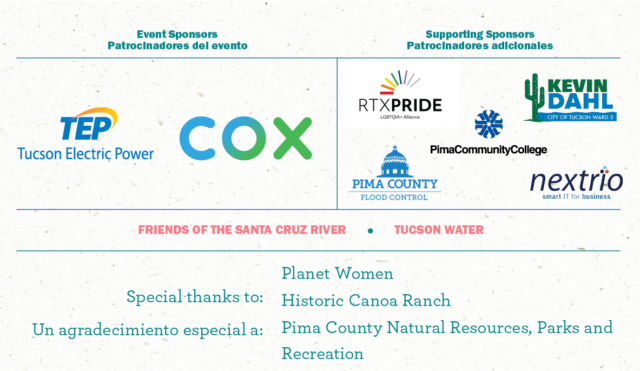“I know that a great deal of collaboration that went onto include so many entities – solutions to our environmental problems will only be solved through such collaborative actions. I like facts and figures and was pleased that the presenters spoke to all those present – not just academics.”
– Feedback from conference attendee
Santa Cruz River Research Days brings together scientists, community leaders, students, and officials from local, state, and federal government agencies. For more than 13 years, the conference has provided a venue to share research findings that impact the lives of residents and wildlife along the Santa Cruz River from Mexico to Marana, and this year we welcomed participants once again to attend in-person for the first time in three years. The two-day conference was conducted simultaneously in English and Spanish, and this year, an in-person field trip explored Historic Canoa Ranch, in Green Valley, Arizona.
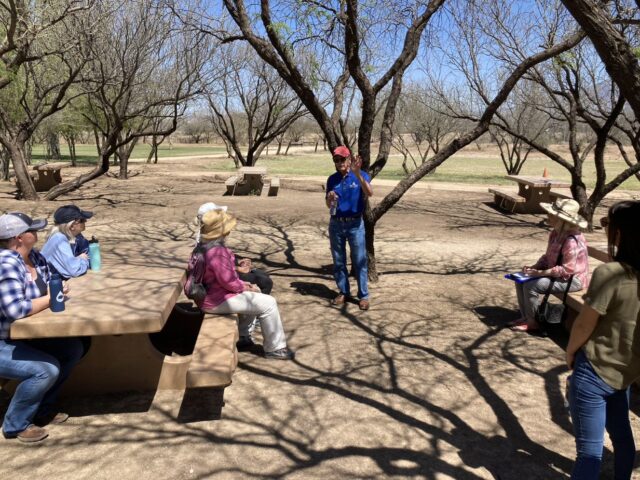
photo courtesy of Claire Zugmeyer.
The theme for this year’s Research Days was Raising All Voices in Conservation. Presentations covered a variety of topics, and the cultural significance of the Santa Cruz River was clear, as well as the importance of the river to nearby communities. A highlight of the event was our two keynote speakers. On day one, Ward 1 Council Member Lane Santa Cruz spoke about their work to support the communities of Ward 1, screening a clip about public transit development in Bogota, Colombia, to support the need and benefit of transit-oriented development and encouraging biking and walkability in Tucson’s urban areas. Santa Cruz also spoke to other work in Ward 1, such as conservation, and mitigating the impacts of the heat island effect, which is experienced much more in communities that lack financing and support for green space and other mitigative practices.
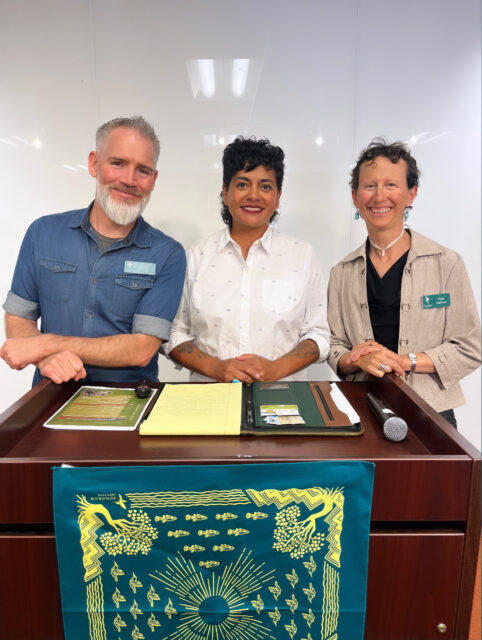
Day two we welcomed Emma Robbins, Executive Director of the Navajo Water Project and Diné artist, who discussed her work and inspirations as an artist, and her ongoing efforts in creating and supplying infrastructure for the many Navajo families who do not have access to running water. Robbins also spoke about The Chapter House, an indigenous women-led community space for art that she founded, where art can be used as a form of connection, empowerment, and education.
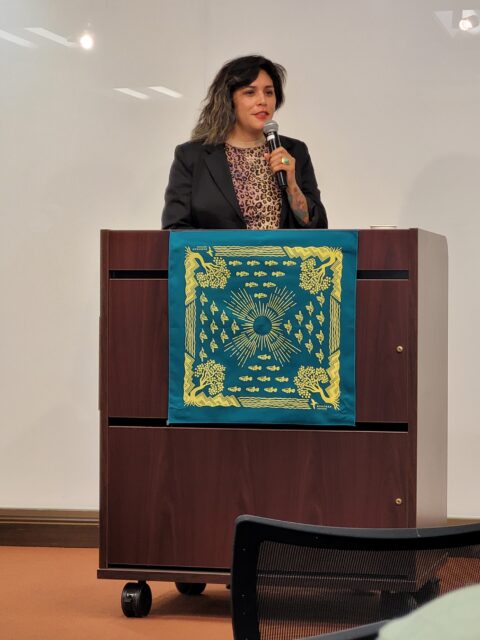
Culture and Connection:
Jacelle Ramon-Sauberan shared an exploration of farming as a way of life for the San Xavier District of the Tohono O’odham Nation, where agriculture has been a mainstay for generations, and the importance of water and place. She discussed how land allotments and developments interact with the changed nature of the Santa Cruz to create challenges and the potential for new innovations by the community in support of generations to come. Josefina Cardenas shared beautiful and insightful poetry written by youth from her own Barrio Kroeger Lane, a celebration of the importance of the Santa Cruz, and the strong connection between the community and the river.
A Legal Perspective:
A legal discussion of two major projects with adverse effect in the Santa Cruz River valley was offered by Dinah Bear, a lawyer with 25 years of service on the White House Council on Environmental Quality, most of which time was spent as the General Counsel, appointed by both Republican and Democrat administrations. Dinah Bear offered valuable insight informed by her storied expertise, exploring the rule of law with regards the USA/Mexico Border Wall and the Copper World Complex proposal (formerly Rosemont Mine). She addressed concerns regarding a declining valuation of the rule of law in the USA, and considered the impact, or absence, of rule of law in these two projects.
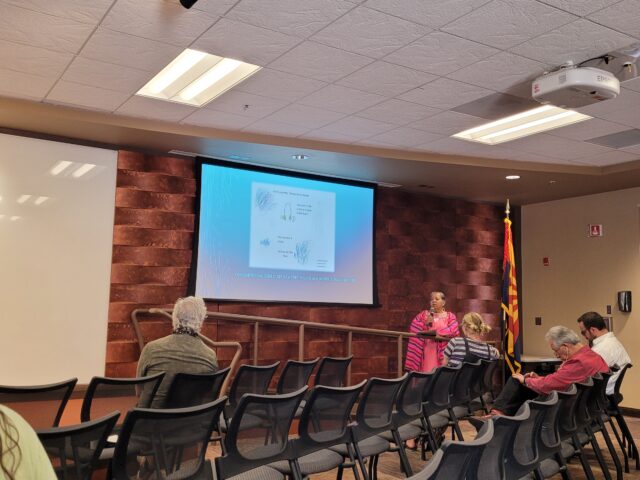
The Urban Interface:
Multiple speakers represented the University of Arizona and discussed the interactions between the Santa Cruz River’s natural and urban environments. An analysis of trash accumulation in the river was offered by Isabella Feldmann, one of a pair of Earth Grant interns working with Sonoran Institute. The impact of urbanization on bobcats was discussed in a paired presentation between Riley Gallagher and Britsy Lozolla-Rizo, looking at both trash and bobcat diets.
The urban-nature interface was also considered by Jennifer Becker of Pima County Flood Control District and Chase Voirin of Harris Environmental Group, who discussed the importance of preparing sites ahead of construction projects, so that species like lizards can be relocated to minimize impact. Jennifer MacFarland took a slightly different approach, looking at methods for engagement and participation opportunities in urban areas for bird conservation, like nest box design for Lucy’s warblers.
Technology and Learning:
Abigail Kahler and Eve Halper presented the Lower Santa Cruz River Basin Study, an investigation into climate change impacts using modelling, and the development of a publicly available interactive data viewer where results of the study can be explored. Laura Palacios Falk of the University of Arizona discussed the development of a model and algorithm allowing for prediction of E. coli levels in the Santa Cruz River’s water. A collaborative effort to provide training, connection, and education for community teachers looking to develop and reinvigorate ecological studies in local schools was presented by Michael Bogan and Rebecca Lipson of the University of Arizona, and Margaret Wilch of the Southern Arizona Regional Science and Engineering Fair.
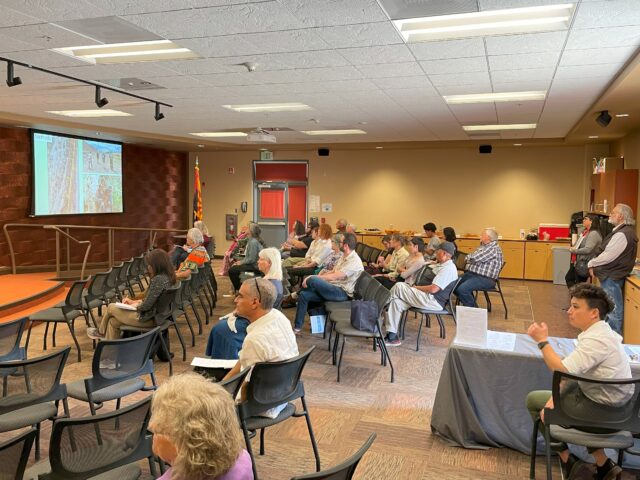
Ecology and conservation:
Multiple presenters discussed a variety of different ecology and conservation topics along the Santa Cruz River. Julia Laurenzi of the University of Arizona spoke about the benefits of treated effluent discharge for diversity and abundance of amphibians and reptiles in the river. Invertebrates were discussed by Ethan Wright of Arizona State University, and Brian Gill of the University of Arizona. Invasive species, like the newly concerning stinknet (see stinknet.org), and native plant restoration where efforts were talked about by Tony Figueroa of Tucson Audubon and Francesca Claverie of Borderlands Restoration Network, respectively, highlighting the importance of monitoring vegetation community compositions and supporting native plant species as much as possible. Other talks included a discussion of the Sonoran Desert Toad, another of the contributions of area-based conservation, and a presentation of river sampling and observation methods undertaken by the Pima County Wastewater Reclamation Department.
“I appreciated how many groups were represented. It is great how a river that was once seen as “dead,”is now bringing people together from all walks of life.” – Feedback from conference attendee
Overall, this two-day event was a wonderful celebration of the Santa Cruz River and its importance to the Tucson communities. We look forward to gathering next year to explore the river and its bounty once again. Santa Cruz River Research Days is part of Sonoran Institute’s Santa Cruz River program. Our focus is to invest in water for the environment and communities along the Santa Cruz River. Our goal for the Santa Cruz is to retain flowing reaches and restore conditions throughout the watershed. We envision a future where a revitalized river corridor is an integral part of our community that strengthens our local economy and reconnects residents of the area to the river. View this year’s recordings in English here. Vea las grabaciones de este año en Español aquí. View proceedings and presentations from past events.
Santa Cruz River Research Days Steering Committee:
- Sonoran Institute
- Michael Bogan, University of Arizona
- Ben Lomeli, Friends of the Santa Cruz River
- Tony Palmer, Tumacácori National Historical Park
We thank our 2023 sponsors:
